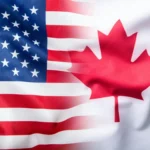
In a swift reaction to the United States’ recent imposition of tariffs, Canada has announced substantial retaliatory measures targeting a wide array of American goods. These developments mark a significant escalation in trade tensions between the two neighboring nations.
Table of Contents
U.S. Initiates Tariffs on Canadian Imports
On March 4, 2025, the United States implemented a 25% tariff on imports from Canada, excluding energy products like crude oil and natural gas, which are subject to a 10% tariff. This action follows a one-month delay intended to allow for negotiations addressing issues such as fentanyl smuggling and migration; however, President Donald Trump deemed these efforts insufficient, leading to the enforcement of the tariffs.
Canada’s Retaliatory Tariffs Take Effect
In response, Canadian Prime Minister Justin Trudeau announced that Canada would impose 25% tariffs on approximately C$155 billion (around $107 billion USD) worth of U.S. goods, effective March 4, 2025. The initial phase targets C$30 billion in goods immediately, with additional tariffs on C$125 billion to follow in 21 days. Trudeau emphasized that these measures would remain in place until the U.S. revokes its trade actions.
Targeted U.S. Products
Canada’s countermeasures focus on a diverse range of American products, including:
- Food Items: Such as dairy, poultry, and grains, affecting U.S. agricultural sectors.
- Textiles and Apparel: Targeting clothing and fabric imports.
- Furniture: Impacting household and office furniture exports.
Notably, these tariffs are designed to affect industries in key Republican-led states, such as Florida and Ohio, thereby exerting political pressure.
Economic Implications and Concerns
The escalating trade dispute raises concerns about potential disruptions to supply chains, increased consumer prices, and slowed economic growth in both Canada and U.S. The Canadian Chamber of Commerce has warned that these tariffs could harm both economies, potentially leading to a recession. Additionally, financial markets have reacted negatively, with U.S. stock prices declining following the tariff announcements.
Impact on Canada’s Real Estate and Mortgage Markets
The trade tensions are expected to have significant repercussions on Canada’s real estate and mortgage markets:
- Construction Costs: Retaliatory tariffs from Canada could drive up the cost of construction materials, affecting housing affordability and supply.
- Economic Uncertainty: A full-scale trade war with the U.S. could send shockwaves through Canada’s economy, raising new concerns for the housing market.
- Interest Rates and Mortgage Costs: Economic instability may influence interest rates, impacting mortgage affordability for Canadian homebuyers.
Potential for Further Escalation
Both nations have indicated readiness to implement additional measures if the situation persists. Canada is considering further non-tariff actions in collaboration with its provinces and territories. Meanwhile, the U.S. has also increased tariffs on Chinese goods by an additional 10%, which China is expected to counteract with its own measures, potentially leading to a broader global trade conflict.
Conclusion
The current trade tensions between the U.S. and Canada represent a critical juncture in North American economic relations. The implementation of reciprocal tariffs underscores the challenges both nations face in navigating complex trade dynamics. The coming weeks will be pivotal in determining whether these tensions escalate further or if diplomatic efforts can lead to a resolution that stabilizes the economic landscape for both countries.
The U.S. & Canada trade war is impacting various sectors, including real estate and mortgages. Cannect highlights how tariffs influence inflation, mortgage rates, and financial stability. As economic pressures rise, staying informed and adapting strategies is crucial for homeowners and investors.
















No Comments